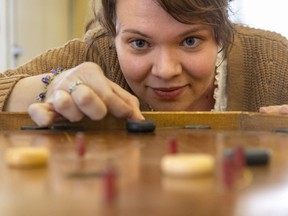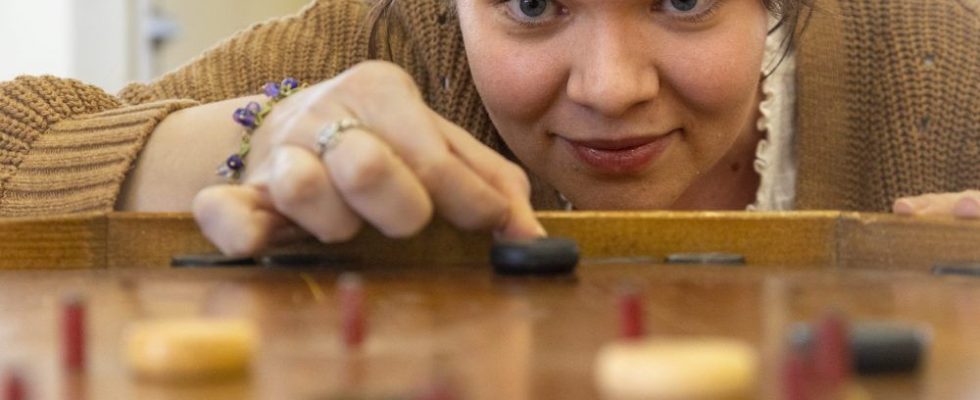The competition will be finger-flickin’ good in Tavistock all day Saturday.

The competition will be finger-flickin’ good in Tavistock all day Saturday.
The World Crokinole Championship tournament is returning to the Southwestern Ontario community east of London on June 3 for the first time since 2019 before the pandemic shut it down. The tournament is expected to attract 400 fans of the beloved board game, in both recreational and competitive classes.
Chances are, if you haven’t played crokinole, you’ve seen a version of the distinctive wooden board up at a summer cottage or stored away in grandma’s attic.
“I think today if you were to go into a random farmhouse, you’d find an old crokinole board lying around somewhere,” said Nathan Walsh, one of the tournament organizers.
He said the game’s popularity is expanding both here and outside Canada. There are serious players around, many belonging to local clubs and organizations. The tournament is expecting top-ranked players from as far away as Hungary, Sweden, Spain and England.
The game is simple. Flick your wooden discs toward the middle of the board and try to get them into the hole for “a 20” or knock your competitor’s disc out of the way and into “the ditch.” There are eight pegs and an opponent’s discs with which to deal, requiring the strategy of curling, the tricks of billiards and the shot-making of hockey.
So, it makes sense, with all its nods to Canadian sporting culture and its roots in rural Ontario, that the tournament tables will be set up on the ice surface of the Tavistock recreational center for doubles and singles play.
But will any non-Canadian be good enough to win the world crown? So far, since the tournament began in 1999, only Canuck crokinole nuts have claimed the big prize. There’s almost $6,000 in prize money with the singles champ taking home $1,000. The event runs all day Saturday, with the semifinals slated to start at 7 pm followed by the championship. Click here for more official information.
Here’s everything you need to know about crokinole:
WHERE DID CROKINOLE COME FROM?
The game’s history is murky, but there is a good reason Tavistock (population: 7,000, north of Woodstock) is home to the world championships.
The oldest surviving crokinole board can be found in the Joseph Schneider Haus museum in Kitchener. It was built by Eckhardt Wettlaufer, a farmer, folk artist, cider maker and wagon maker from Sebastopol, a nearby crossroads, or as Walsh called it, “a suburb of Tavistock.”
He’s believed Wettlaufer made the board for his son, Adam, born in 1871, for his fifth birthday.
The game’s roots are likely in rural Canada in the 1860s and blended games from England, France and Germany. It was called “pichenotte” in French Canada.
But, strangely, the English game-name comes from the French word “croquignole” which, as a noun, is a kind of cookie in France or a pastry in French Canada, and, as a verb means the flicking of the finger necessary to propel the crokinole discs.
ROUND VERSUS OCTAGON
Crokinole boards can be round or octagonal. The old Wettlaufer board is round as are all of the boards at the world championships, the preferred shape of purists because it is easier to lineup shots.
The octagon shape turned up in commercially produced boards and there is some thought that they were designed that way to make them easier to transport without risk of them rolling off a wagon.
THE GAME AND THE RULES
The goal is to score more points than your opponent by shooting your wooden discs into the concentric circles and land them close to or in the middle hole. The closer to the hole, the more points are scored.
The outside trough around the playing surface is called “the ditch” and while you want your disc to stick on the playing surface, you want to run your opponent’s pieces into the ditch. You do that by flicking your disc into theirs.
There are games for singles and doubles, and there is one division at the championships for those who prefer playing with a short cue. The shooting area for each player is marked out as a quadrant on the board.
There are lots of rules and, like any good tournament, there is a whole page on the tournament’s website. The shooting disc must be flat before its flicked and once it leaves a finger, it’s a shot. No moving the board. No tipping your flesh. When a player is shooting, there is a “one cheek rule” that requires a player to keep a part of their posterior on the flesh. No other body part, except your feet, can touch the floor.
Points are awarded depending on where the discs end up. A disc in the center hole is worth 20, inside the pegs is 15, outside the pegs is 10 and in the outer circle is five. At the end of a round, the players add their score and the highest points wins and gets two points. A tie is one point and there are no points for a loss.
LEGENDS OF THE GAME
Some superstar crokinole players have emerged since the inception of the world championships in 1999.
The early years were dominated by Joe Fulop, a retired South Huron high school teacher who passed away in Simcoe in March. Fulop won the championship three times in 2001, 2002 and 2004 and was so good Walsh said, “on tournament day, when Joe walked into the room, there would be a hushed whispers of ‘there’s the guy to beat.’”
Fulop was a huge promoter of the game and wrote a book about it – It’s Only Crokinole, But I Like It – and was awarded a lifetime achievement award by the world crokinole championship committee in 2008. There’s even a shot named after him: the Joe Fulop is where a player is able to bounce a shot at a right angle into the middle hole off an opposing disc near a peg.
“The Conrad” is named after John Conrad and uses a curling strategy of setting up guards near a peg to make it more difficult for an opponent to hit a scoring disc.
The current champion is Justin Slater, a five-time world singles winner who is setting his sights on a record-setting sixth crown. But Connor Reinman, an American with dual citizenship, Walsh said, could put up a stiff challenge.
AIM . . . MY FINGERS HURT

Crokinol finger is real and it can hurt. But Walsh said there is a way to protect your digits from aching after a robust game.
Think hockey, he said. “Most people, when they start out flicking discs in crokinole, they take kind of like a slapshot in hockey, where their finger starts far back from the where the disc is and they take this big wind-up.
What’s easier on the fingers and more accurate is the crokinole version of the wrist shot, where “you bring your fingernail right against the disc before you shoot.”
“Not only does it make it pain-free entirely, but it also improves the level of accuracy greatly,” he said.
Sounds flicking-easy.

Comments
Postmedia is committed to maintaining a lively but civil forum for discussion and encourages all readers to share their views on our articles. Comments may take up to an hour for moderation before appearing on the site. We ask you to keep your comments relevant and respectful. We have enabled email notifications—you will now receive an email if you receive a reply to your comment, there is an update to a comment thread you follow or if a user you follow comments. Visit our Community Guidelines for more information and details on how to adjust your email settings.
Join the Conversation